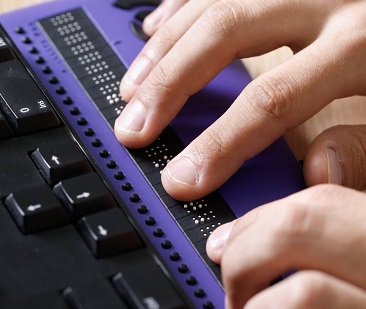Reasons Why We Need to Give Picture Captions an Upgrade
by Beth
 I am pleased to introduce Bridgit Kuenning-Pollpeter as a guest blogger today. Her work has appeared in 13th Floor, Breath and Shadow, Misbehaving Nebraskans, and many other publications, and her guest post today discusses inclusion and assistive technology. She lives in Omaha with her husband and two sons. “They provide endless material for my writing,” she says. “When they give me the time!”
I am pleased to introduce Bridgit Kuenning-Pollpeter as a guest blogger today. Her work has appeared in 13th Floor, Breath and Shadow, Misbehaving Nebraskans, and many other publications, and her guest post today discusses inclusion and assistive technology. She lives in Omaha with her husband and two sons. “They provide endless material for my writing,” she says. “When they give me the time!”
by Bridgit Kuenning-Pollpeter
My fingers manipulate keys, navigating Facebook. Arrowing down, the cursor lands on a picture and I hear, “Two people and a Baby.”
Great, I think, no context. I continue to arrow down, finding another picture. This time, the electronic buzz of my computer’s voice says, “Man in sunglasses.” Again, zero context for me.
Fifteen years ago, I became visually impaired. I transferred my visual understanding of the world into a non-visual medium. To use a computer, I now use a program called JAWS, which is a text-to-speech screen reader. It reads whatever the cursor highlights, allowing me to still do email, Google-search, write and of course, shop! However, if pictures and graphics are not properly captioned, I have no clue what they are.
When submitting my written work to publications, I only consider those that have online access. Publications with easy navigation for my screen reader provide me with the same opportunity sighted writers have to read pieces and study submission guidelines.
Since becoming blind, my life does not feel less than, as if I’m missing out on something. I do have to navigate the world non-visually, though, and that is made more difficult when accessibility is not a factor.
Some platforms have created generic captions that interact with screen readers, but they provide bare-bones details. Example: if a picture is of a group taken outside, my screen reader will likely say, “Several people in nature.” I have no clue what is in the picture, or what kind of nature scene it is. I don’t need a dissertation on the pic, but, some context and brief detail is good.
If posting a photo of you and your baby, JAWS might tell me, “Woman and baby.” I want some extra detail to paint a visual in my head.
Rather than help, generic captions like the ones above just make graphics pesky, uninteresting, and not-useful pieces of information. Placing a caption under pictures and graphics (and providing a brief description of content if the formatting is experimental) allows people with visual impairments to have equal access.
As a nonfiction writer, I write about the world, using my experiences to address discrimination, isolation, acceptance, breaking stereotypes, usually in context to disability. As a writer, I participate in classes, retreats, conferences and workshops, and often, we are given very visual exercises.
Recently, I was asked to create a visual memory map. This emphasis on the visual is prevalent in the writing community, but thinking of non-visual means to achieve writing goals is a good sensory exercise for all writers, not just those of us who are blind.
I ended up writing a timeline with descriptions of place instead of drawing a map. Having been sighted for twenty-two years, I can recall visual memories in my mind, but creating them on a piece of paper is difficult.
While I’m actually still a visual person, constantly creating visuals in my head, and while I think visual references can be great and beneficial for sighted writers, I’m also now in this other world where non-visual means of accessing the world make more sense and are much more helpful.
Inclusion and equality for all is a big topic these days. However, disability is usually missing from the discussion. It’s not always intentional, we just need more education about accessibility. As the artistic community moves forward, as the world moves forward, we need to consider accessibility, and make disabled people an active part of the conversation. Often, it doesn’t take much to make information accessible, but it has to be considered, then implemented.
I want to work with the writing community to bring attention to this issue and help create resolutions. The world is a better place when inclusion involves all of our voices.
A longer version of this post was originally published in June, 2019 on Brevity’s Non-Fiction blog.






